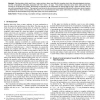Free Online Productivity Tools
i2Speak
i2Symbol
i2OCR
iTex2Img
iWeb2Print
iWeb2Shot
i2Type
iPdf2Split
iPdf2Merge
i2Bopomofo
i2Arabic
i2Style
i2Image
i2PDF
iLatex2Rtf
Sci2ools
TVCG
2008
2008
Visualizing Incomplete and Partially Ranked Data
Ranking data, which result from m raters ranking n items, are difficult to visualize due to their discrete algebraic structure, and the computational difficulties associated with them when n is large. This problem becomes worse when raters provide tied rankings or not all items are ranked. We develop an approach for the visualization of ranking data for large n which is intuitive, easy to use, and computationally efficient. The approach overcomes the structural and computational difficulties by utilizing a natural measure of dissimilarity for raters, and projecting the raters into a low dimensional vector space where they are viewed. The visualization techniques are demonstrated using voting data, jokes, and movie preferences.
| Added | 16 Dec 2010 |
| Updated | 16 Dec 2010 |
| Type | Journal |
| Year | 2008 |
| Where | TVCG |
| Authors | Paul Kidwell, Guy Lebanon, William S. Cleveland |
Comments (0)

